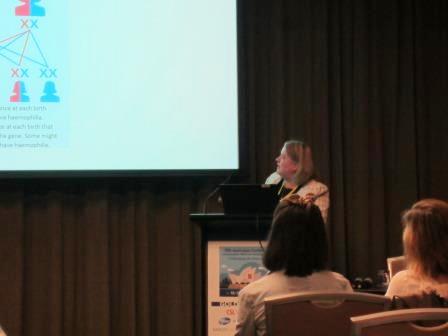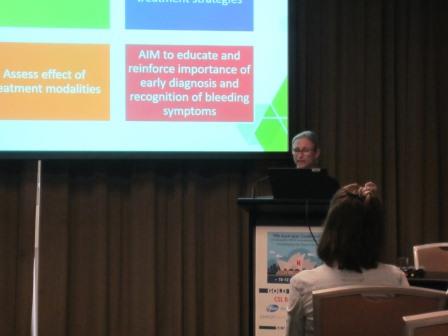SUSAN DALKIE
Susan Dalkie is the Bleeding Disorders Nurse – NT, Royal Darwin Hospital
The line-up of sessions provided at this Conference was one of the best that I have ever seen. There was a wide range of topics discussed, including future treatment options and clinical trials for patients with bleeding disorders, such as gene therapy for haemophilia. The challenges and issues faced with both the paediatric and aging populations with haemophilia were also interesting topics, along with joint care and healthy living options for all ages.
Chair: Susan Dalkie
Personal story: self-management, diaries, what a parent wants to know ~ Shauna
Female Factors – issues for different life stages and how to handle them ~ Dr Jenny Curnow
The gynaecologist and patients with bleeding disorders ~ Dr Kim Mathews
Carriers: What do parents, young girls and women need to know? ~ Joanna McCosker
I have a personal interest in women’s health and bleeding disorders. Therefore, it was an honour to have been able to chair the Saturday morning session, From girls to women.
The session featured four different speakers who outlined issues that affect women and girls with bleeding disorders.
Shauna was our first speaker who shared her personal story with the audience regarding living with and managing her VWD. (see Managing my VWD – Shauna’s story in this issue of National Haemophilia)
Shauna highlighted the fact that she was diagnosed with Type 3 VWD and with no apparent family history, her parents had to manage her symptoms the best they could along with support from their local HTC team.
Shauna pointed out the importance of keeping a record of her bleeding symptoms throughout the years to assist the HTC team in providing her with an appropriate and effective care plan.
Stepping into adolescence with Type 3 VWD as a girl was not easy. Shauna suffered from very heavy periods with haemorrhaging ovarian cysts. She voiced her gratitude to her women’s health medical team working very closely with her HTC team in managing her symptoms.
She explained that over the years her treatment plan changed from her treating bleeds ‘on demand’ to changing over to ‘prophylaxis’ treatment. She pointed out that she had already suffered from previous joint bleeds, particularly into her knee which had caused significant damage. The decision to go onto prophylaxis treatment was to try to prevent any further joint damage and to manage her bleeding episodes more effectively.
Lastly, Shauna spoke about how she personally helps herself in dealing with the challenges she faces with living with VWD. She keeps herself well informed, she ensures she keeps the lines of communication open about her VWD, and most importantly she remains active, tries new things to see what helps her the most and continues on enjoying life.

Dr Jenny Curnow discussing the medical aspects
Both Dr Jenny Curnow and Dr Kim Matthews provided the audience with information on the issues women with bleeding disorders face during their lifetime; in particular, during the reproductive years. Dr Matthews also went into further detail, explaining from a gynaecological perspective the medical interventions available to help women manage menorrhagia, such as using the Mirena® IUD (intrauterine device) plus or minus in combination with the oral contraceptive pill and tranexamic acid.
Dr Matthews explained the importance of carefully monitoring these women during pregnancy and how having an effective treatment plan for the birth is imperative to prevent complications such as post-partum haemorrhage. She also mentioned that during the birthing process, due care must be taken to protect the baby in case he/she also has a bleeding disorder. Therefore, to prevent injury to the neonate, procedures such as suction and forceps delivery should not occur. Comprehensive care of the mother and baby will ensure the best outcome, which includes involvement from the paediatrics, haematology and obstetrics teams.
In my opinion, women with bleeding disorders are at times at a disadvantage due to the old fallacy ‘women don’t have bleeding disorders’; not all health professionals take their bleeding issues seriously. Luckily, this notion is slowly disappearing, but it is imperative that we continue to educate the wider community about these issues. I think both presentations by Dr Curnow and Dr Matthews covered this perfectly.

Jo McCosker presenting on haemophilia carriers
The last presentation of the session was by Joanna McCosker, Haemophilia Nurse Practitioner from the Queensland Children’s Hospital. Many people are confused as to what defines a haemophilia carrier; however, Joanna’s presentation beautifully explained the meaning of being a carrier in simple terms enabling everyone in the audience to understand. As with Dr Curnow’s and Dr Matthews’ presentations, Joanna pointed out the consequences of bleeding in this cohort of women and the importance of performing genetic testing early enough for them to manage and make informed decisions regarding their reproductive health.
One of the more important take home messages for me from this presentation was ‘for every 1 male with haemophilia there are up to 5 female carriers!’
I thoroughly enjoyed chairing this session and found all four presentations excellent. It is reassuring to know that there are other clinicians around Australia advocating for women and young girls with bleeding disorders. With the provision of further support and education to patients, families and medical health professionals, these women have a bright future ahead knowing that their bleeding issues can and will be well managed.
Haemophilia Foundation Australia acknowledges the Traditional Owners and Custodians of Country throughout Australia, the land, waters and community where we walk, live, meet and work. We pay our respects to Elders past and present and extend that respect to all Aboriginal and Torres Strait Islander peoples.
Sign up for the latest news, events and our free National Haemophilia magazine